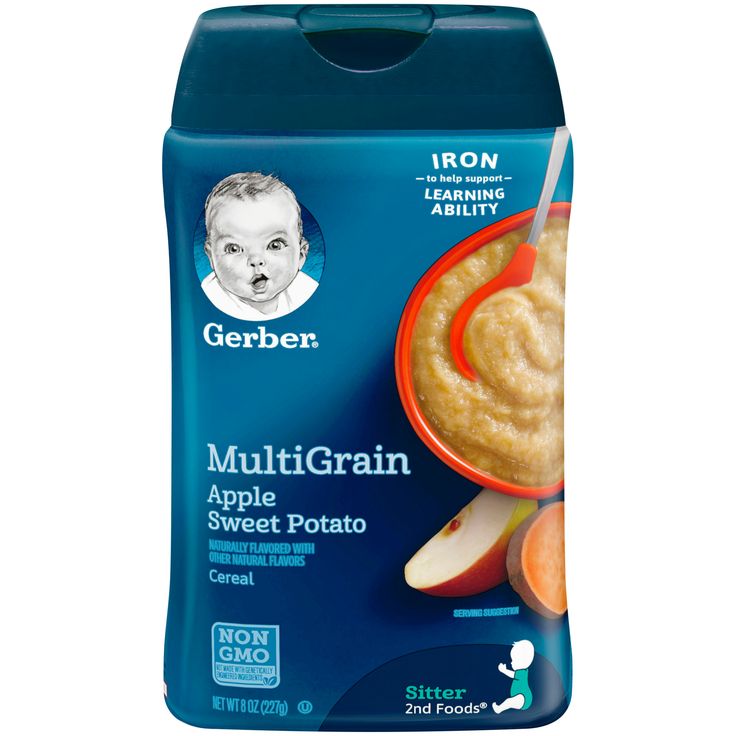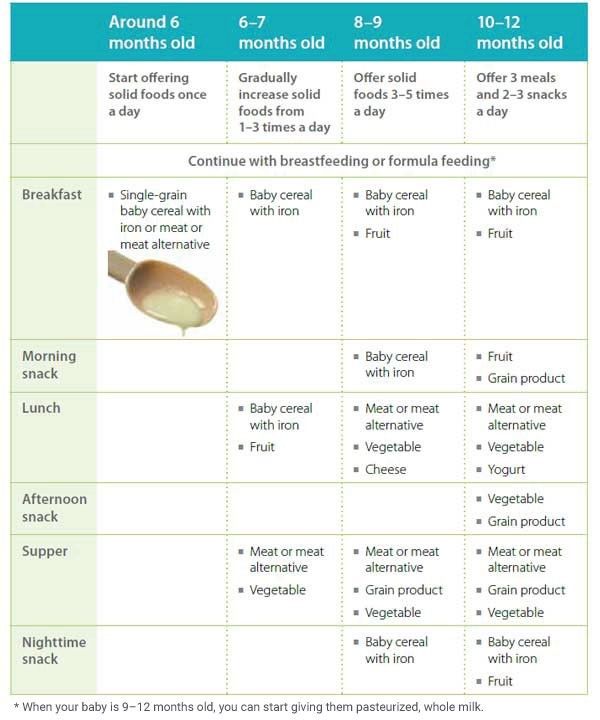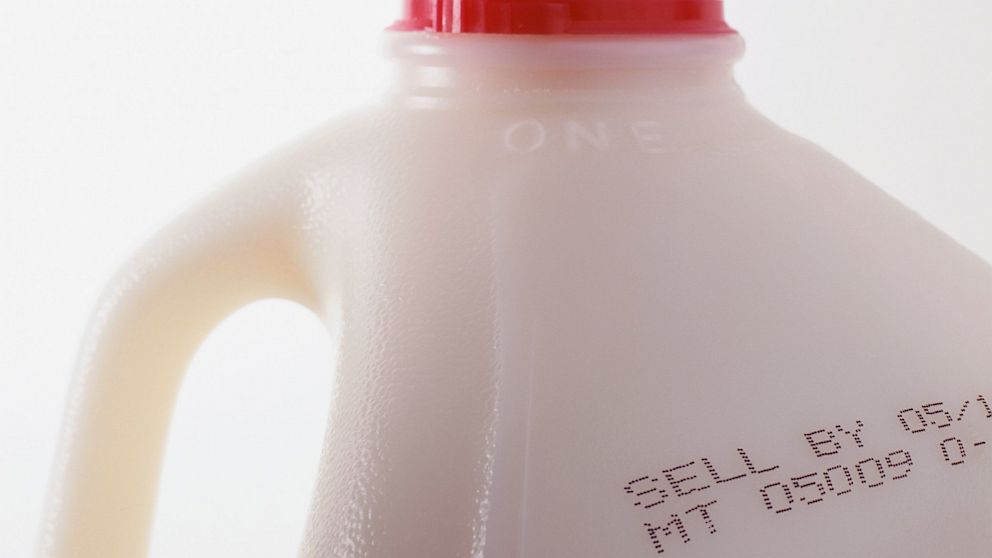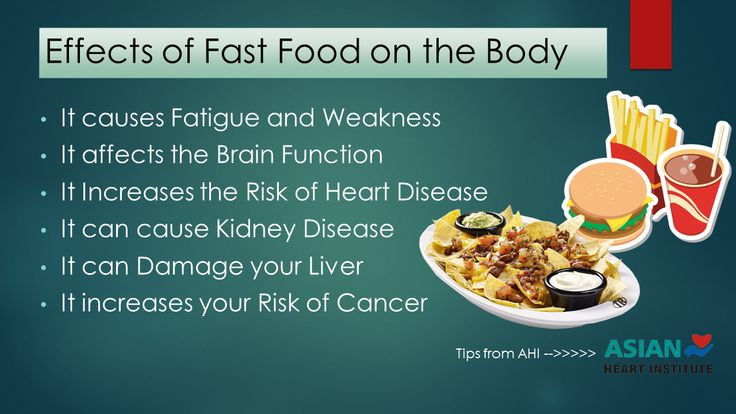What age should babies feed themselves with a spoon
When to Introduce a Spoon to Baby
Learning how to self-feed is an important milestone in your baby’s development. The messy, but fun, process of teaching your baby how to use a spoon will be the next step in your baby’s journey to self-feeding.
Teaching your baby how to self-feed is going to be a messy process, but will be worth it in the long run. Your baby's motor skills and development will benefit from learning how to self-feed so it is important to encourage this process to your baby. As you begin to approach the age where your baby is ready to start learning how to self-feed, here is everything you should consider.
Where To Start
Finger Feeding
Before you start to think about introducing a spoon to your baby, you first will want to make sure your baby has been introduced to finger foods. This first step will help your baby begin to develop their motor skills which are necessary to have before figuring out how to use a spoon.
Beginning with finger foods, start with soft foods that you can easily smash with your fingers. This will be the safest and easiest place to start for your baby. Foods such as soft cooked noodles, cut bananas, or steamed veggies are all a good place to begin. Choosing foods that can be cut up into bigger chunks will also make it easier for your baby to be able to pick up.
If you have only been feeding your baby soft foods and purees on your own, you should wait to introduce a spoon until after you have introduced finger foods. At around 12 months, most babies should be feeding themselves finger foods. It is around this stage that you can start to introduce a spoon.
Next Step: Introducing the Spoon
Now that your baby has gotten comfortable with finger feeding, you can take the next step on the self-feeding journey by introducing their first utensil, a spoon. The CDC recommends waiting to introduce a spoon to your baby until they are around 10-12 months old. However, there is no specific age or time that your baby should developmentally be using a spoon. There are many factors that can have an influence on the timing of your baby learning to use a spoon.
- Fine motor skill development
- Interest in eating independently
- Time they have been eating solid foods
- First introduced to finger foods
These are all factors that can influence when your baby starts to use a spoon to self-feed. Every child is unique so do not worry about whether or not your baby is successfully learning to use a spoon. They will get there eventually!
Signs They Might Be Ready
It can be tricky to know whether or not your baby is ready to take the next step in their development. One sign that your baby is likely ready to start using a spoon on their own is with their body language. Infants typically will turn their heads and clamp their mouth to signal they are full, after the meal. The opposite holds true as they get older. Toddlers will often start to get fussy or throw a tantrum before a meal. If you are noticing that they are appearing disinterested in the spoon you are trying to feed them, let themselves give it a try.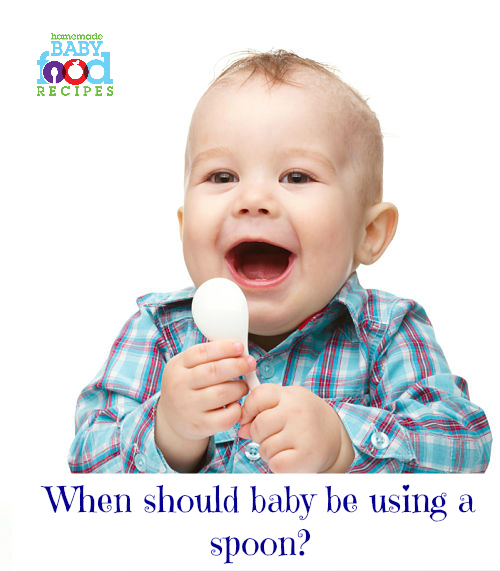 This might be their way of telling you they are ready to be more independent.
This might be their way of telling you they are ready to be more independent.
Learn more from Pediatrician Dr. David Hill from the American Academy of Pediatrics about when your baby is ready for solids:
Expected Timeline
Depending on your baby, these milestones will be reached at different times than the families around you. However, here is a general guide to understanding when you should plan on your baby reaching these steps to independently self-feeding.
- 6 months: You can begin to start introducing finger foods to build your baby’s fine motor skills. Remember to choose foods that are soft and easy to squish to avoid any choking hazards.
- 12 months: Around their first birthday, your baby will likely begin showing an interest in using a spoon themselves.
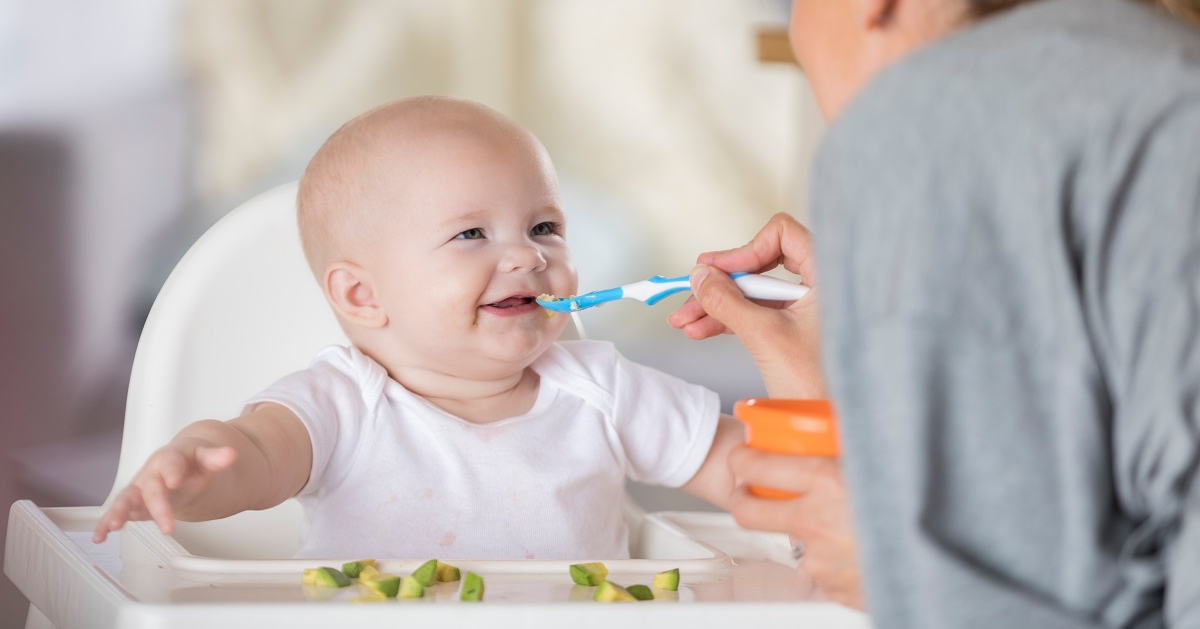 This is when you can begin letting your child feed themselves thick, soft foods like oatmeal, yogurt, or applesauce.
This is when you can begin letting your child feed themselves thick, soft foods like oatmeal, yogurt, or applesauce. - 15-22 months: Your toddlers should be able to start getting the hang of feeding themselves with a spoon. Around this time, you should also be able to introduce using a fork to feed themselves.
Every baby is different when it comes to reaching these developmental milestones. You should never focus too much on whether or not your baby is “on track.” With both time and practice, your baby will get there.
What are the Benefits of Self-Feeding?
Self-feeding is your baby’s first step to independence. In addition to the new confidence and sense of freedom your baby is experiencing, self-feeding is beneficial to their overall development in the following ways.
- Learning to grasp and hold things firmly
- Gaining hand-eye coordination (learning spatial awareness, strengthening their “visual motor skills”)
- Refining Sensory Process skills (the different textures and sensations of the food they are touching will help to build their sensory processing skills)
Things to Consider
Picking the Right Spoon
In general, any spoon that is not too heavy for your baby to hold is the right spoon.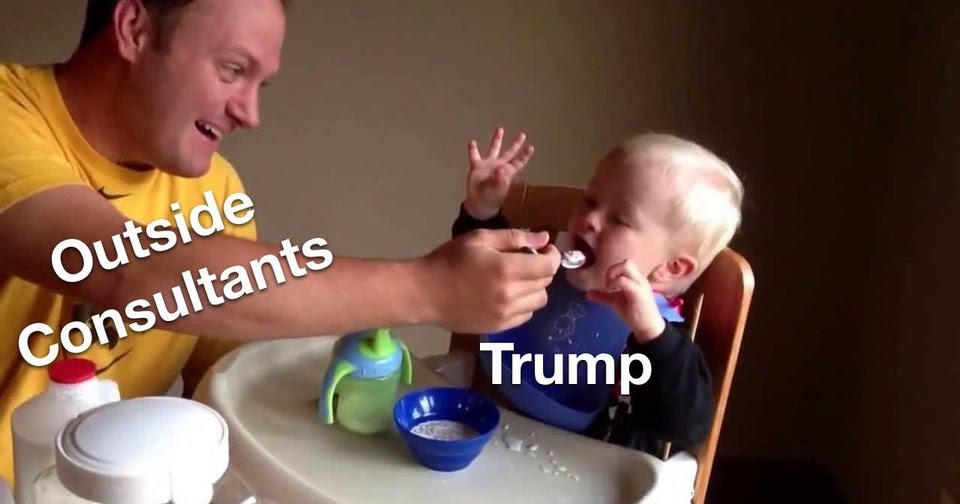 However, it is probably a good idea to purchase a set of spoons that are actually designed to be used for babies. Look for spoons that have a wide, chubby handle that will make it easy for your baby to grab and pick up. A spoon made of rubber or silicone will also be better for your baby because of the soft texture and grippy material.
However, it is probably a good idea to purchase a set of spoons that are actually designed to be used for babies. Look for spoons that have a wide, chubby handle that will make it easy for your baby to grab and pick up. A spoon made of rubber or silicone will also be better for your baby because of the soft texture and grippy material.
Foods to Start With
Get ready for a big mess when it comes to your baby learning how to use a spoon. At first, your baby will likely spend more time exploring and playing with their food, rather than actually eating it. Start with thick foods that will easily stay on the spoon as they learn how to balance and bring the spoon to their mouth. Here are some recommended foods to start with.
- Applesauce
- Cottage cheese
- Mashed peas/carrots
- Mashed potatoes
- Oatmeal
- Pasta
- Pudding
- Yogurt
Introducing the Fork
So, your baby has now mastered the spoon and is ready for their next big step: the fork. It is usually recommended to introduce the spoon before the fork, because a spoon is typically easier for a baby to learn at first. However, some babies do pick up on the fork easier because it requires less balancing and they can stab the food. You will likely want to introduce the fork at around 16-18 months, to give your baby time to first practice and focus on learning how to use a spoon.
It is usually recommended to introduce the spoon before the fork, because a spoon is typically easier for a baby to learn at first. However, some babies do pick up on the fork easier because it requires less balancing and they can stab the food. You will likely want to introduce the fork at around 16-18 months, to give your baby time to first practice and focus on learning how to use a spoon.
What’s Next?
With so many huge developmental milestones being achieved, your baby is rapidly developing. Once your baby has been introduced to the spoon and fork, you can consider moving them from the high chair to a booster seat at the table. By bringing your baby to the table to eat with you, you can help them develop their motor skills quicker. This gives them the opportunity to observe and mirror your actions.
How Can I Help the Process?
The best way you can help your baby is to simply let them experience and explore this new skill for themselves. At first, you'll probably notice that your baby spends more time playing and waving the spoon around. But eventually, they will start to pick up on how to actually use the tool for their self-feeding benefit.
But eventually, they will start to pick up on how to actually use the tool for their self-feeding benefit.
This is a messy, but fun, process. Look into some rubber or silicone splat mats to make the clean up aftermath easier for you. Other than letting your baby explore and have fun with the learning process, here are some things you can do to help your baby with practicing their new skill.
- Demonstrate it for them: Your baby is looking to you for guidance, so show them how it is done! Have them watch you use a spoon to feed yourself the yogurt or oatmeal and then have them try it for themselves. Over time, they will continue to mirror your actions for how to self-feed.
- Hand-Over-Hand Method: First, let your baby grab for the spoon themselves. Once they are holding the spoon, see if they can dip the spoon and scoop up the food. You can place your hand over their hand and help guide the food into their mouth. Your baby is still learning all the basics like where their mouth even is and how to scoop food using the spoon so you can help show them the ropes for the first few times.
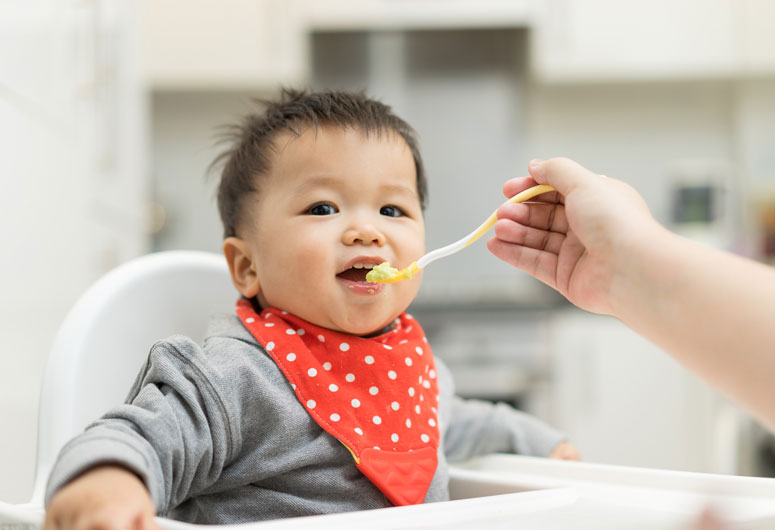
- Stick to Thick Foods: To make it easier for your baby to scoop and bring the food into their mouth, stick to thick foods at first. Avoid foods that can easily fly off the spoon (rice, cereal, etc.) until they have gotten used to the process.
Baby-Led Weaning: What is it?
Baby-Led Weaning is a popular form of teaching self-feeding. The process skips feeding soft foods and purees and goes straight to finger foods starting at around 6 months. Registered dietician, Clancy Cash Harrison, author of Feeding Baby, says “Baby-led weaning supports the development of hand-eye coordination, chewing skills, dexterity, and healthy eating habits,” she says. “It also offers babies an opportunity to explore the taste, texture, aroma, and color of a variety of foods.”
What makes baby-led weaning successful, is that your baby will recognize that in order to eat, they need to learn how to do it themselves. It gives an extra nudge into independence. However, parents can obviously step in when needed, in order to make sure their baby is getting enough nutrition from food.
However, parents can obviously step in when needed, in order to make sure their baby is getting enough nutrition from food.
Starting at about 6 months, or whenever your baby is able to sit unassisted in a high chair, you can begin baby-led weaning. Your baby might not have fully developed their chewing skills so breast milk or formula will still need to be their main source of nutrition until at least 10 months old.
The best foods to begin with are soft, easy to squish foods like bananas, steamed broccoli, or avocado. Try cutting the foods into bigger pieces to make it easier for them to pick up. By starting at 6 months, you will help your baby develop the pincer grasp. When considering foods to start with, texture is key. Since your baby does not have the fully developed chewing skills, you will want to make sure any food you are giving them is very soft to avoid a choking hazard.
If you are thinking of starting baby-led weaning, consider a mixed approach. The first few months of baby-led weaning might be more exploring, and less eating. Do not feel pressure to fully abandon breast milk, formula, or purees. Not all children will be ready for baby-led weaning and finger feeding at 6 months. Focus on making sure your baby is getting enough food, rather than trying to get them to self-feed.
Do not feel pressure to fully abandon breast milk, formula, or purees. Not all children will be ready for baby-led weaning and finger feeding at 6 months. Focus on making sure your baby is getting enough food, rather than trying to get them to self-feed.
The most important thing to take away from both self-feeding and baby-led weaning is to let your baby lead the process. Let them be the one to reach for the spoon, show their curiosity, and explore their growing independence. Your baby will be most successful if you let them guide you in this process.
--------------------------------
All health-related content on this website is for informational purposes only and does not create a doctor-patient relationship. Always seek the advice of your own pediatrician in connection with any questions regarding your baby’s health.
These statements have not been evaluated by the Food and Drug Administration. Products are not intended to diagnose, treat, cure or prevent any disease.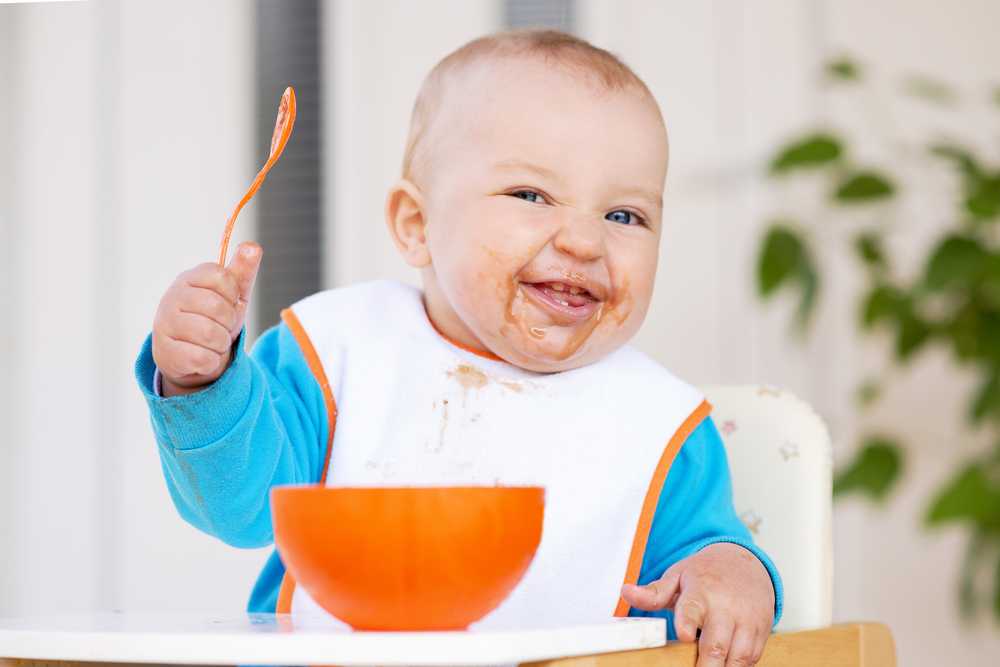
See the FDA Peanut Allergy Qualified Health Claim at the bottom of our homepage.
When Can Babies Use a Spoon and Fork? – Happiest Baby
By Gabrielle McPherson, MS, RDN, LDN
Once your rookie eater has graduated from milk to solid foods, they may be ready to take the job of eating into their own hands with a baby-friendly fork or spoon. Sure, it won’t be pretty (sweet-potato splatters on the ceiling, anyone?), but it will allow your kiddo’s developmental skills to soar, as they creep closer to eating independently with the rest of the family!
With some patience (and, let’s be honest, lots of clean-up), you’ll help your mini muncher explore eating in a way that makes them feel a little more in charge at mealtime. But you don’t have to go it alone! We’re here to tell you what you need to know about your little one’s readiness for spoons and forks, what to look for when shopping for baby utensils, and what foods to offer as you introduce these new tools.
When can babies use spoons and forks?
From 6 months: Let your baby explore with a spoon.
Around the 6-month mark you probably introduced solids for the first time. Maybe you spoon-fed your little one mashed banana, watching their eyes widen in disbelief that something could taste so yummy. As your baby gets more confident with feeding, they may also literally try to take matters into their own hands by grabbing the spoon. That’s because around 6 months, babies use their whole hands to hold items in their view, also known as the palmar grasp. Though yes, it will result in a mess, go ahead and give into your little grabber! This is the first stage of utensil use. If your tot’s handsy-ness is interfering with your ability to zoom little bites into their mouth, you could even offer them one spoon to hold and chew on while you use another to feed them.
From 10 months: Babies start to use spoons and forks independently.
If your baby isn’t trying to snag the spoon from your grasp during feeding time, that’s perfectly okay, too, because babies aren’t usually ready to use forks and spoons independently until 10 to 12 months. At this point, your baby can start to feed themselves with utensils. Just keep in mind that they aren’t yet eating experts, and they won’t use utensils every time they eat. At this age, your tiny gourmand is starting to pick up foods using their pincer grasp (meaning they employ their pointer finger and thumb to grab finger foods). You may notice around this age that they're more interested in using their utensils, though they will be using their fingers to eat most of the time.
At this point, your baby can start to feed themselves with utensils. Just keep in mind that they aren’t yet eating experts, and they won’t use utensils every time they eat. At this age, your tiny gourmand is starting to pick up foods using their pincer grasp (meaning they employ their pointer finger and thumb to grab finger foods). You may notice around this age that they're more interested in using their utensils, though they will be using their fingers to eat most of the time.
From 18 months: Baby’s fork and spoon use improves as motor skills grow.
You can expect your kiddo to be a spoon-and-fork novice for quite some time, and they should start using utensils with less of a mess somewhere between 18 and 24 months. Around this time, your tot will use spoons and forks more consistently.
How can I help my baby or toddler use utensils?
Offer utensils during infancy.
Whether spoon-feeding pureed foods, feeding via baby-led weaning (BLW), or doing a combo, it helps introduce a spoon and fork to your baby around 6 months.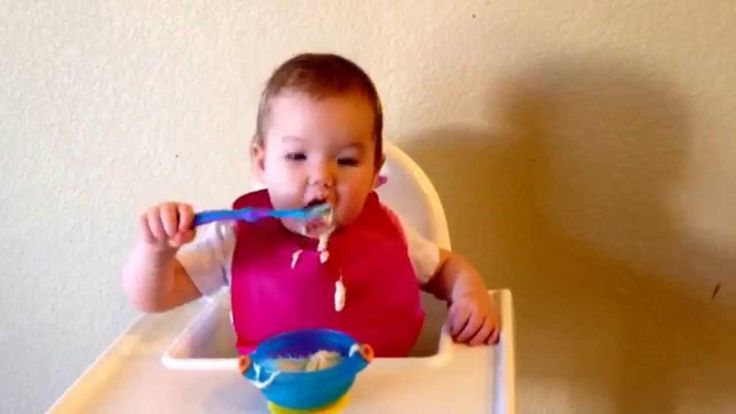 Since your little is newly eating, you might consider offering “pretensils:” dippable utensils that bypass any need for scooping or poking. Pretensils trap purees with a single dip, making them easy to use for your tiny eater. Or depending on the thickness of the puree, a regular silicone baby spoon might work fine (simply dip the spoon into your puree, and give your little one the handle to hold).
Since your little is newly eating, you might consider offering “pretensils:” dippable utensils that bypass any need for scooping or poking. Pretensils trap purees with a single dip, making them easy to use for your tiny eater. Or depending on the thickness of the puree, a regular silicone baby spoon might work fine (simply dip the spoon into your puree, and give your little one the handle to hold).
Early exposure to feeding tools can get little ones used to the idea of using them. Of course, don’t expect your baby to use a fork or spoon “the right way” for a while! Spoons and forks for young babies are just for learning, growth, and practice. As your wee one gets comfortable with utensils, they may deploy them primarily for play. When it comes to actually getting food into the mouth, hands are still the best utensil at this age! Using hands to eat helps build oral-motor skills while offering them a tasty sensory experience.
Pre-load baby purees on a spoon.
Babies typically learn to use spoons before forks. At 6 months, babies are still improving and fine-tuning their hand-eye coordination. They won’t be able to successfully scoop up a spoonful of yogurt on their own or spear a piece of salmon with a fork. Gripping utensils with tiny hands, moving the arms, and bringing them to the mouth takes tons of coordination, and your baby will be working on skill development here. Babies can grow frustrated when they can’t get food to their mouths (we’ve all been hangry before, right?). To lessen the potential food fury, pre-load your tot’s utensil and hand it to them; from there, they’ll know what to do!
At 6 months, babies are still improving and fine-tuning their hand-eye coordination. They won’t be able to successfully scoop up a spoonful of yogurt on their own or spear a piece of salmon with a fork. Gripping utensils with tiny hands, moving the arms, and bringing them to the mouth takes tons of coordination, and your baby will be working on skill development here. Babies can grow frustrated when they can’t get food to their mouths (we’ve all been hangry before, right?). To lessen the potential food fury, pre-load your tot’s utensil and hand it to them; from there, they’ll know what to do!
Model utensil use during meals for your baby.
Your baby is watching you to figure out how forks and spoons work. Prioritize eating together, so Baby learns self-feeding skills through your example. Bring the highchair or toddler seat to the family table, so your peanut has a front-row seat.
What should I look for in utensils for my baby or toddler?
The grownup silverware will need to wait until your baby is older.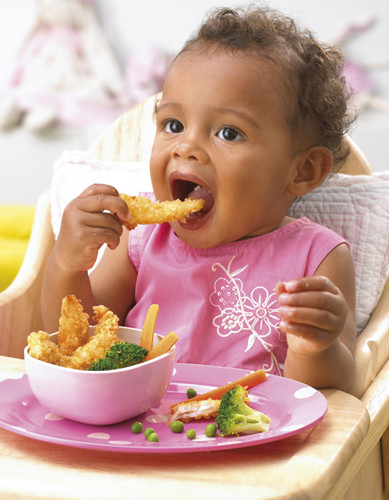 In the meantime, you’ll want to stock up on baby- and toddler-friendly forks and spoons.
In the meantime, you’ll want to stock up on baby- and toddler-friendly forks and spoons.
Here’s what to look for in baby and toddler utensils:
- Easy-to-grip
- Easy-to-clean
- Wide short handle (for babies 6+ months)
- Lightweight
- Silicone or another soft material
- BPA-free
- Durable
- Curved forks (helpful for toddlers)
- Blunt end (once your baby graduates to stainless steel toddler utensils)
What foods are best when introducing utensils?
Best Foods for Baby Spoons
Babies need time to get the hang of spoon usage, so you as the parent or caregiver will be doing most of the feeding until they’re more developmentally ready to spoon-feed on their own, around 10 to 12 months.
When introducing spoons, offer purees or thicker foods starting from 6 months:
- Cream of wheat
- Oatmeal
- Unsweetened applesauce
- Plain whole-milk yogurt
- Pudding
- Fruit/veggie smoothie bowl
- Bowl of cereal (Cheerios + formula or breastmilk) starting at 9 months
Best Foods for Baby Forks
It’s okay to introduce forks early on, but don’t expect your baby to use them with ease until around 18 months. When introducing forks, offer finger foods that are easily poke-able:
When introducing forks, offer finger foods that are easily poke-able:
- Cubed avocados
- Diced squash
- Chopped turkey meatballs
- Diced pancakes
- Diced cheddar cheese
- Chopped tofu
- Cut-up boiled egg
- Diced seedless watermelon
- Diced sweet potatoes
More Tips on Feeding a Baby:
- Best First Foods 6 to 9 Months
- Best First Foods 10 to 12 Months
- How to Introduce a Cup
- Quick Guide to Homemade Baby Food
About Gabrielle McPherson
Gabrielle McPherson, MS, RDN, LDN is registered dietitian in Missouri who specializes in community and pediatric nutrition. Gaby is passionate about encouraging families to eat well in simple, practical ways that are realistic...and delicious! When not working, Gaby loves cooking, baking, and making messes and memories with her sous-chef/preschooler Charlotte.
View more posts tagged, feeding
Have questions about a Happiest Baby product? Our consultants would be happy to help! Connect with us at customercare@happiestbaby.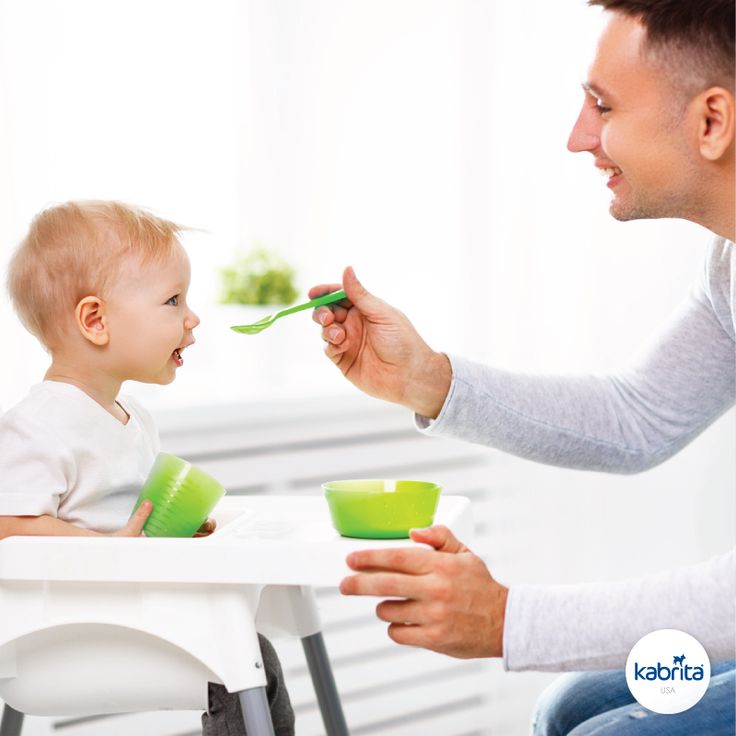 com.
com.
Disclaimer: The information on our site is NOT medical advice for any specific person or condition. It is only meant as general information. If you have any medical questions and concerns about your child or yourself, please contact your health provider.
How to teach a child to eat with a spoon and at what age is it better to start
Usually, parents feed their children from a spoon not out of emotion, but for practical reasons: it’s faster and cleaner. Pediatrician Olga Kulakova explains at what age a child can handle eating with a spoon and fork and whether this process can be somehow accelerated.
Question. My daughter is already 1.5 years old, and she just can't eat with a spoon on her own. By what age should a child learn to use cutlery? And are there ways to teach him?
Answer. The first acquaintance of a child with a spoon begins in the first year of life and coincides in time with the beginning of the introduction of complementary foods. At 6–7 months, the baby may begin to show interest in the spoon as an object. This is an excuse to buy another baby spoon and put it next to the plate. Let the child turn it in his hands, examine it and try to use it for its intended purpose.
At 6–7 months, the baby may begin to show interest in the spoon as an object. This is an excuse to buy another baby spoon and put it next to the plate. Let the child turn it in his hands, examine it and try to use it for its intended purpose.
At around 9 months of age, your baby can start picking up a spoon on their own. But this does not mean that he will be able to scoop up food and bring it to his mouth. Rather, it is about the fact that the child is trying to copy the movements of adults.
A child usually masters a full-fledged spoon by about one and a half years. But here it is important to remember that everything is very individual. Someone already a year old is excellent at using a spoon, and someone is still fed by their parents even at two years old. And it’s not worth worrying that the child is over a year old, and he is still just learning and he doesn’t succeed.
Under no circumstances should children be forced to master this science. Aggressive training can cause a backlash: the child will no longer want to pick up cutlery.
How to teach a child to use a spoon:
- Have him sit at a common table, let him watch how family members eat.
- Do not force feed your baby. Let him eat with his hands. He will not be able to eat porridge and soup like that - he will have to try to master the spoon.
- Play role-playing games with him more often, in which the child feeds his toys from a spoon.
At this age, the child actively copies the behavior of his loved ones, and it is important that he sees how the whole family eats with cutlery.
Children learn to use a fork around the age of three: at this age they already understand that a fork is a sharp object and can be hurt.
Pay attention to how the child grasps cutlery:
- At 1-2 years old, he holds a spoon in his fist in the middle of the handle.
- By two years - closer to the wide back.
- From the age of three, he can begin to hold the spoon with three fingers: thumb, index and middle.

Sooner or later the child will pick up the spoon and fork on his own as it should be
Children are given large time intervals to acquire certain developmental skills. For example, some children can learn to walk at 9 months, and others by one and a half years, and both will be the norm. The same story with cutlery: one child may become interested in them at 7–8 months, another at 9 months or after a year. All of these are variations of the norm.
However, by the age of two, a child should normally pick up a spoon and try to eat on his own. This does not mean that he will eat all the soup in the bowl, but at least a few spoons he should be able to bring to his mouth.
Ask your question to Mel, and the editors will find someone who can answer it. Write to our social networks - we read all messages on the pages on Facebook, VKontakte and Odnoklassniki. You can also write to us on Instagram. Answers will be published in order of priority in the "Question - Answer" section. By the way, we do not disclose names, so questions can be anything (feel free!).
By the way, we do not disclose names, so questions can be anything (feel free!).
Prepared by the trainee Anastasia Shirokova. Cover photo: Shutterstock / FotoDuets
Until what age should a child brush their teeth, feed from a spoon and go to the toilet with him
Education
- Photo
- Getty Images/EyeEm Premium
Psychologist, medical psychologist "SM-Clinic"
-
Perhaps many mothers and fathers will be surprised: how can you harm your baby, because we are his helpers! The fact of the matter is that excessive attention and guardianship can play a negative role. I knew a mother who couldn't sleep because she was worried about her 7-year-old son's briefcase. As a result, she got up and reported the necessary textbooks. Or a grandmother who 9- the classmate wore a briefcase. Truly, love knows no boundaries, but is it love?
Truly, love knows no boundaries, but is it love? The movement towards development and autonomy is inherent in a person from birth. Only after being born, the baby already knows how to do a lot: yawn, suck, breathe, look, go to the toilet. Gradually, from about four months old, he begins to need an adult less and less. First, he starts playing with toys himself and spends some time without his mother, then he learns to sit down, then walk. The child really likes to learn, and with the right support from an adult, he quickly and with pleasure masters new actions.
myself!
There is no answer to the question at what age a child should definitely develop some kind of skill. Even siblings rarely start talking and walking at the same time. The psychological literature describes the most favorable periods during which certain skills develop.
For example, by the end of the 12th month the child should try to drink from a cup by himself, and by the end of the 18th month he should eat with a spoon.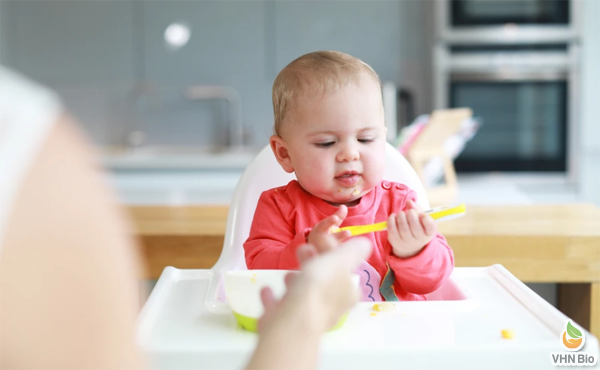 But someone can learn this earlier, so there is no point in comparing children with each other, as well as looking for reasons for concern. Another thing is when the world around does not arouse interest in the child to learn it, or the necessary skills do not appear during the specified period - then you need to contact a specialist.
But someone can learn this earlier, so there is no point in comparing children with each other, as well as looking for reasons for concern. Another thing is when the world around does not arouse interest in the child to learn it, or the necessary skills do not appear during the specified period - then you need to contact a specialist.
- Photo
- Getty Images
Doctors advise taking care of the oral cavity of a baby almost from birth. And when the first teeth appear, we go for a children's hygiene kit. With today's choice of toothpastes, brushes and gadgets, brushing your teeth can be turned into a fun game and a daily ritual. And it doesn’t matter that the result will be so-so at first - it’s not the gods who burn the pots!
Step by step, without irritation, with a smile, teach your baby and help - brush your teeth until he can do this procedure correctly.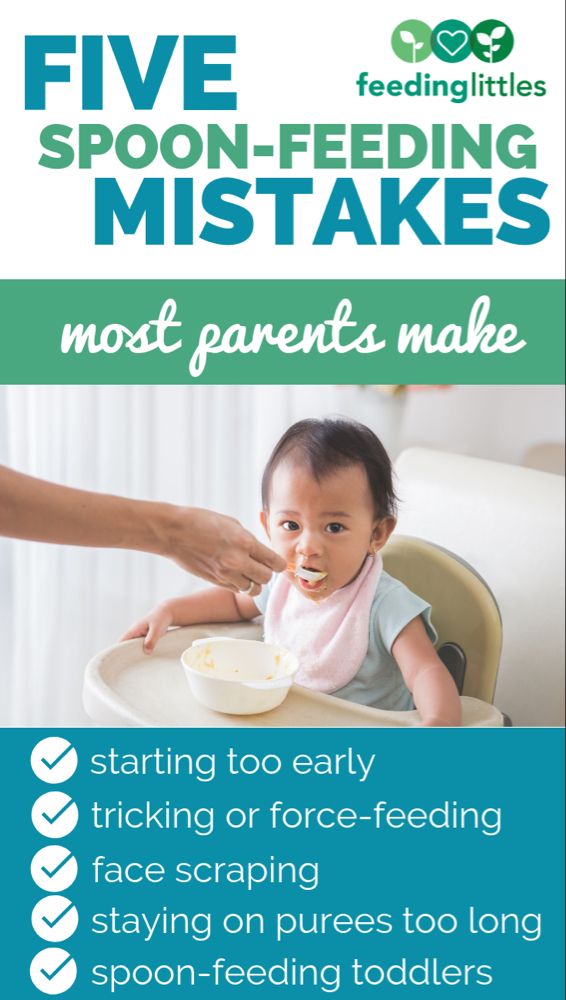 And for this, the child should at least be able to confidently hold objects in his hand and perceive safety rules: do not eat toothpaste, do not put the brush down his throat, etc. You can read a book together about the bunny that the toothbrush came to, and then tell your loved ones about it dolls, and even better - take them to the bathroom for a useful procedure.
And for this, the child should at least be able to confidently hold objects in his hand and perceive safety rules: do not eat toothpaste, do not put the brush down his throat, etc. You can read a book together about the bunny that the toothbrush came to, and then tell your loved ones about it dolls, and even better - take them to the bathroom for a useful procedure.
What should be avoided in the learning process:
-
violence and negative emotions;
-
tantrums and screams;
-
jerks and hurries;
-
condemnation and ridicule;
-
overprotection.
What will help to cope with the task:
-
positive attitude and humor;
-
role play;
-
personal example;
-
praise, and it is necessary to praise correctly - not to support the child's ego: "You're doing well," but the action: "Hurrah, you did it."
-
diversity, boredom is not the best ally.
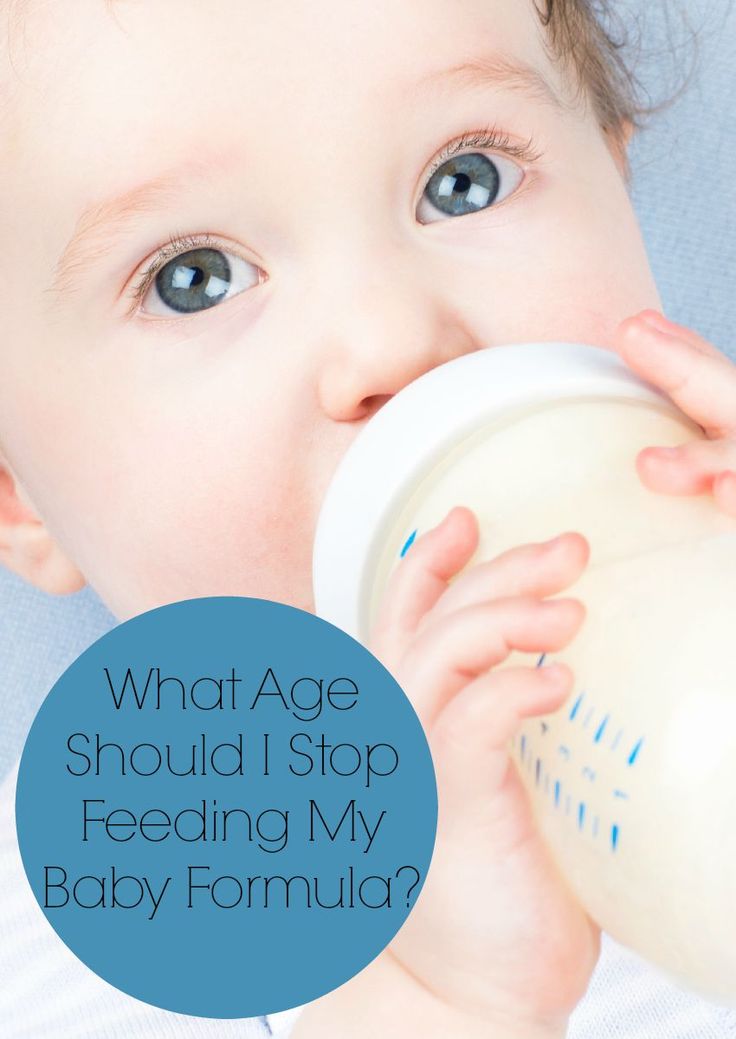
Mom, I need to pee
Potty training, like self-care skills, happens gradually. By about a year, the child begins to notice and pay attention to what is happening to him, and by the age of one and a half, he begins to warn about the urge to go to the toilet. Attentive parents notice: the baby slows down, may stop, blush, and then report that he has already done something in his pants.
First, you should call a spade a spade, and then show where and how the child can be freed. But before potty training, it is important that he feels the discomfort of wet and soiled panties. After all, if he is constantly in diapers, how does he know that the discomfort is due to the results of his life?
Parents can patiently explain how to act so that there are no troubles. It is good if relatives notice when the baby pees - after eating or after sleeping, and warned these moments by planting them on the potty. And put on a diaper only for a walk or a night's sleep - then the child will quickly begin to understand what a potty is.
- Photo
- Martin Novak/Getty Images
One of the most common stages of learning about the world and yourself is a child playing with poop. Noticed? Do not rush at him with loud cries! The kid perceives this "beauty" as part of himself and may feel pride in the fact that he himself produced it. Naturally, he wants to play all this, and we must give him such an opportunity - until he has a feeling of disgust: it smells bad.
Education mistakes
– The line between help and care is very thin, and parents are responsible for it, our expert emphasizes. - Only they, watching the baby, know what he is able to do on his own, and where else he needs help.
Independence and initiative are qualities for which a child has a natural need. It is important to always show them, but especially up to 9 years.

If a child at this age is not allowed to actively explore the world and try his hand, instead of autonomy, he may develop shame, guilt and self-doubt. And this will then in one way or another affect his self-confidence, confidence or insecurity. Notice that the baby has no shame, no guilt, no doubts, he is open to everything new, actively repeats new movements, rejoices in success. The task of adults is not to drown out this desire, but to support it: to be near, praise, help, but not do it for him.
It's like the problem: to feed or not to feed? Most parents choose the first option, they say, the child will remain hungry, and scatter food. But listen, at this moment you care about your own convenience and the image of an ideal mother (“my child is always clean and tidy”), and not about his development! And at what age will he, poor fellow, learn to recognize the feeling of fullness if his mother and grandmother take turns offering him spoon after spoon?
Same with potty training.

